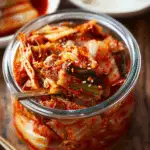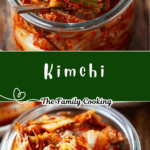Kimchi
Kimchi is a traditional Korean dish made from fermented vegetables, typically napa cabbage and radishes, flavored with a spicy paste of chili peppers, garlic, ginger, and fish sauce. It’s known for its tangy, spicy, and umami flavors, packed with health benefits.
- Prep Time: 45 minutes
- Cook Time: 5 minutes
- Total Time: 3-4 days (including fermenting time)
- Yield: 4-6 servings
- Category: Side Dish
- Method: Fermented
- Cuisine: Korean
- Diet: Vegan
Ingredients
- 1 medium napa cabbage (or 1 small head)
1/4 cup sea salt (for salting the cabbage)
4 cups water (for brining)
1 tablespoon grated ginger
1 tablespoon minced garlic
2 tablespoons fish sauce (or vegan alternative like soy sauce)
2 tablespoons Korean red pepper flakes (gochugaru, adjust for spice level)
1 tablespoon sugar
1 tablespoon rice flour (or plain flour)
1/4 cup water
2 tablespoons soy sauce (optional for added umami)
2 medium-sized Korean radishes, peeled and sliced (or substitute with daikon radish)
3–4 spring onions, chopped (optional)
Instructions
Prepare the cabbage: Cut the napa cabbage into quarters and remove the core. Slice the cabbage into bite-sized pieces, then place them in a large bowl. Sprinkle the cabbage with sea salt, ensuring the leaves are evenly coated. Add the water to the bowl to cover the cabbage. Let it sit for 1-2 hours, tossing the cabbage every 30 minutes to make sure it evenly wilts and softens.
- Prepare the kimchi paste: While the cabbage is resting, make the kimchi paste. In a small saucepan, combine the water and rice flour, bringing it to a boil over medium heat. Stir frequently until it thickens into a paste, about 2-3 minutes. Remove from heat and let it cool. Once cooled, add the grated ginger, minced garlic, fish sauce (or soy sauce for a vegetarian version), Korean red pepper flakes (gochugaru), and sugar to the paste. Stir everything together until well combined. This is the flavorful kimchi paste that will coat your vegetables.
- Rinse and drain the cabbage: After the cabbage has softened and wilted, rinse it thoroughly under cold water to remove the excess salt. Drain the cabbage well, ensuring there’s no excess water left, which could dilute the kimchi paste.
- Combine the cabbage and kimchi paste: Once the cabbage is drained, transfer it to a large mixing bowl. Add the radish slices, and then toss in the kimchi paste, using your hands or gloves to massage the paste into the vegetables. Make sure every piece is well-coated in the flavorful paste.
- Pack the kimchi into jars: Pack the kimchi into clean, airtight glass jars or containers, pressing the mixture down to ensure there are no air pockets. Leave about an inch of space at the top to allow room for the kimchi to expand as it ferments.
- Ferment the kimchi: Leave the jars at room temperature for 1-2 days to ferment. The length of fermentation will depend on the ambient temperature—warmer environments will ferment the kimchi faster. You can taste it daily to check its tanginess. Once it has reached your desired level of fermentation, transfer the kimchi to the refrigerator. The cooler temperature will slow down the fermentation process, and the kimchi will continue to develop flavor over time.
- Serve: Kimchi is best served cold, straight from the fridge, but can also be used in soups, stir-fries, and other dishes. Serve it as a side with rice, on top of noodles, or as a topping for tacos, fried rice, or sandwiches.
Notes
- Vegan Kimchi: Omit the fish sauce and use extra soy sauce or tamari. You can also replace it with miso or other umami-rich ingredients for flavor.
- Spicy Kimchi: Adjust the amount of gochugaru (Korean chili flakes) to suit your spice tolerance. You can add more chili flakes or even chopped fresh chili peppers if you like it extra hot.
- Sweet Kimchi: Add a little more sugar or fruit, like pear or apple, to the kimchi paste for a sweeter version. The natural sugars from the fruit balance the acidity and spiciness.
- Storage: Kimchi can be stored in the refrigerator for up to 1-2 months. It will continue to ferment slowly, becoming more tangy and flavorful over time.
- Reheating: Kimchi is typically served cold, but you can also use it in hot dishes like kimchi fried rice, soups, or stews. Just add it towards the end of cooking to maintain its flavor and texture.
Nutrition
- Serving Size: 1 serving
- Calories: 15
- Sugar: 2g
- Sodium: 200mg
- Fat: 0g
- Saturated Fat: 0g
- Unsaturated Fat: 0g
- Trans Fat: 0g
- Carbohydrates: 3g
- Fiber: 1g
- Protein: 1g
- Cholesterol: 0mg
Find it online: https://thefamilycooking.com/kimchi/

